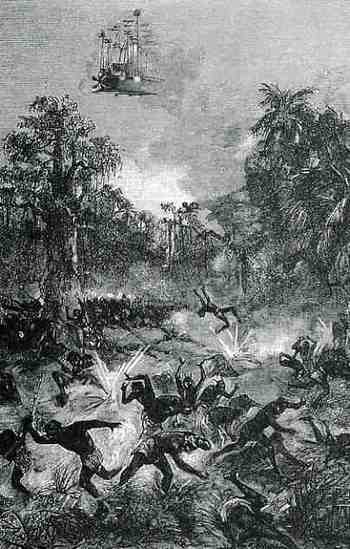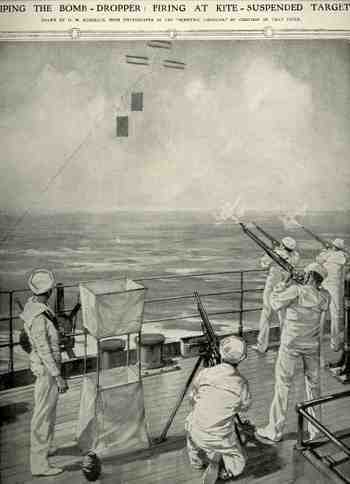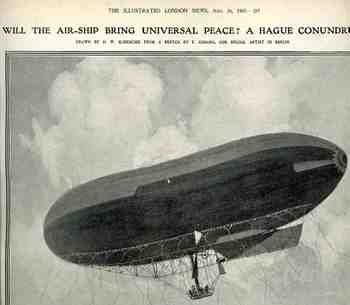JF Ptak Science Books Post 322
I had written out a good, chunky post on the history of the images of aerial bombing; wrote it all down in my little notebook down at Tybee Island, and then promptly hopped into the hot tub fully clothed (for the benefit of our five-year old Tessie) and stayed there for a half-hour, with my notebook still in my pocket. Of course once the thing sort of dried out all of the notes were just one blue stain, an Andy Warhol post. I just can't do the whole thing over again, but I can post about the one odd bit that was in there. And it is this (very) minor bit that escaped Sven Lindqvist's attention in his glorious A History of Bombing (printed in 2000 by The New Press), a book that is a chrono-intellectual historico-philosophical treatment of aerial bombing in general.

One of the earliest illustrations of bombing from an airship (at left) occurs in the incomparable Jules Verne's Roburs the Conquerer (also known as The Flight of Engineer Roburs) in 1886. It turns out that this floating monstrosity (the Goahead) made its way slowly over Paris, illuminating the city with powerful lights, in a helpful, positive way; on the other hand, it confronts "dark criminals" with bullets, mowing them down. Oddly enough, the book's opening two words are "Bang Bang".

This may well be the first anti-aircraft (and anti-bomber) image ever printed in England--it comes from The Illustrated London News for 16 December 1911, just six weeks after this same magazine printed the first image of an aircraft dropping a bomb on a military target. (And it seems originally to have been first published weeks earlier in the U.S in the Scientific American.) "Airman-shooting with Springfield Rifle; Aerial Gun Practice on a United States Battle-Ship" is the sub title to "Sniping the Bomb-Dropper: Firing at Kite-Suspended Targets" . The kites carried the targets up to a height of about 300 feet, and the navy let loose with "one-pounders and three-pounders" as well as rifles (?!) The text to the print continues the story: "The Springfield rifle...will afford no inconsiderable defense against any aeroplane that might attempt to execute feats of 'bomb-dropping'." I don't know about that, though it may have been true that this 30-caliber weapon with a muzzle velocity of 2700'/sec might've done some damage to a 1911 aircraft....I guess they could have tracked it too, what with the plane moving 75 miles an hour or so.
It was just a few years earlier that in this same journal (for 4 August 1907) that the possibility of the air-ship being an instrument of peace was discussed. It seems that this "peace" would come about in a sort-of MAD (mutually assured destruction) kind of way, stumbling its way to peace because of the difficulty in defining the terms of war--rather than obtaining a stalemate by the endgame of obliteration via inconceivable amounts of instantaneously-released energy, these folks thought that peace/stasis might come about simply because they weren't able to fully outlaw reckless bombing because they couldn't come to terms with what an "airship" actually *was*. Bombing by airship was outlawed at the Hague Conference of 1899, and in 1907 it was argued that a five-year extension of that treaty should be enacted--again, mainly due to the ungentlemanly ungainliness of what it meant exactly to drop bombs from the air and what aspects of that action were illegitimate.
All sides would get over the definition issues pretty quickly, as 1912 comes up just a little short of the guns of November two years hence. After all, we can't have ill-defined terms in communication, can we?




The Goahead ... at first, I thought that was Howl's Moving Castle. Didn't they ... I mean, They ... use unmanned balloon bombs in WWII? The Japanese sent them as terrorists to our Pacific coast, I think, though without much effect (I'm just passing along hearsay).
Posted by: Jeff | 19 October 2008 at 12:46 AM
You're right about Howl--they DO look very similar...these are my favorite sorts of flying vessels....Robida's creations too. The Japanese did float over balloons with incendiary stuff as payload (?)....I remember that they used the work of an overlooked Japanese meteorologist to get the "bombs" over the Pacific. I'm pretty sure that nothing ever happened as a result, though they did make it over the ocean. They *did* cause a commotion, which is about as much as they could do, Now if they filled up the sky with such stuff, somehow, now that would be a different matter.
Posted by: John Ptak | 19 October 2008 at 10:17 AM
according to my brain a woman and five children were killed by one of the fire balloons. another victory for the magnificent theory of area bombing. http://en.wikipedia.org/wiki/Fire_balloon#Single_lethal_attack
Posted by: lobstershriek | 11 February 2009 at 05:36 AM